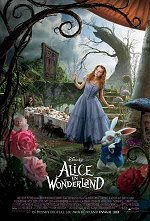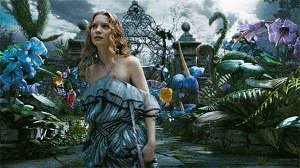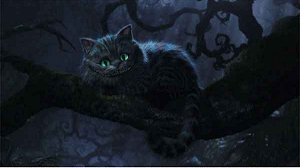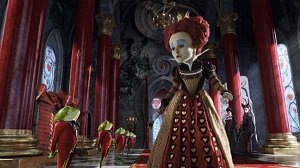 |
|
At The Picture Show
|
March 2010
The looking-glass is half-full
Wonderland gets the Burton treatment in visually striking but uneven 'Alice' re-telling

Alice in Wonderland
Walt Disney Pictures
Director: Tim Burton
Screenplay: Linda Woolverton, based on the books Alice's Adventures in Wonderland and
Through the Looking-Glass, by Lewis Carroll
Starring: Mia Wasikowska, Johnny Depp, Helena Bonham Carter, Anne Hathaway, Matt Lucas,
Crispin Glover and the voices of Stephen Fry, Michael Sheen, Alan Rickman and Timothy Spall
Rated PG / 1 hour, 48 minutes
Opened March 5, 2010


 < (out of four)
< (out of four)
There are certain expectations of a Tim Burton film. His signature characteristics are
unmistakable; we can recognize one of his movies instantly.
The problem with having that kind of definable quality is that, after a while, we know - or think
we know - exactly what to expect. I mean, who didn't have some kind of assumption about
what a Burton Alice in Wonderland would look like?
 All the more remarkable, then, that Burton's Wonderland
(Underland, actually) manages to surprise us. It's not that he's radically changed his style - far
from it; he's as recognizable as ever. But the inventiveness of his designs, his color choices, his
expansive landscapes and idiosyncratic details, make palpable a world most of us thought would
be all too familiar by now. Color me surprised; the trailers made the film seem not only
annoying and ugly, but stale.
All the more remarkable, then, that Burton's Wonderland
(Underland, actually) manages to surprise us. It's not that he's radically changed his style - far
from it; he's as recognizable as ever. But the inventiveness of his designs, his color choices, his
expansive landscapes and idiosyncratic details, make palpable a world most of us thought would
be all too familiar by now. Color me surprised; the trailers made the film seem not only
annoying and ugly, but stale.
Thankfully, that's not the case. Alice in Wonderland is far from a perfect movie, but what it does
best is place us in a setting that exemplifies the atmosphere of nonsense and hallucinogenic
absurdity that the story requires. We are surrounded by grotesques, beautiful in their garishness;
by duskily-lit trees, plants, weeds and branches, wrapping around on themselves in a maze of
theatrical contortion. We never feel like we're on level ground; the only thing that keeps us
grounded is Alice (Mia Wasikowska), who's all too convinced that this is all a dream.
Naturally, after a time it doesn't really feel that way to her anymore - encounters with the Blue
Caterpillar (voiced by Alan Rickman), the spectacularly designed Cheshire Cat (Stephen Fry),
the eccentric Mad Hatter (Johnny Depp) and the malevolent Red Queen (Helena Bonham Carter)
convince her otherwise. (On a side note, if not for what was almost certainly a studio
requirement to get a PG rating, Burton could have easily nudged this a bit more into the horror
category, which would have been really interesting. Alas . . .)
 Adding to the eeriness is the Wonderland characters'
insistence not only that Alice has been here before, and not only that she is "supposed" to kill the
Jabberwocky and shift the balance of power in Wonderland, but that she already has - and,
therefore, must do so again.
Adding to the eeriness is the Wonderland characters'
insistence not only that Alice has been here before, and not only that she is "supposed" to kill the
Jabberwocky and shift the balance of power in Wonderland, but that she already has - and,
therefore, must do so again.
In this area, the film is fascinating. There is the suggestion of a circular narrative in Wonderland
- that this story is already a part of history as it plays out, that all this has occurred time and time
again. In a sense, the movie is serving as a commentary on itself and the established history of
Alice in Wonderland - acknowledging that this tale has been told before, that we know where the
pieces are all supposed to go, that these particular versions of characters we already know are
acting out a dream based upon a dream based upon a dream . . .
That self-awareness allows the film to have fun with its own take on the narrative, subverting
established storylines and characters (including making Alice a 19-year-old young woman,
haunted by recurring dreams and vague memories of experiencing Wonderland as a child) while
fulfilling its "obligation" to destiny, or whatever destiny would be called in a place like this.
That being said, the emphasis on plot points is a sort of handicap as well - mostly because it
detracts from what the film does best, which is indulging itself in the pure spectacle of its visual
fantasy. It's so easy to get immersed in each physical setting that being reminded that there's a
story being told is something of a nuisance at times. More than anything, we'd love to sit down
and stay awhile in the woods, or the Red Queen's castle, or the tea party . . . except all these darn
plot points keep getting in the way, and we have to move along
That may be "disciplined" structure, but it's also a buzzkill.
 And as stellar as Burton's visual creations in Alice are,
often-poor computer animation prevents it from being as fully realized and immersive as it wants
to be. The issue is the filmmakers' inability to reconcile certain very false-looking animatronic
images - the White Rabbit, for example - with the live actors and the rest of the elements of the
production design. Scenes work best when the CGI isn't interfering. But interfere it does - not
throughout the film, as I'd dreaded, but certainly in a number of moments.
And as stellar as Burton's visual creations in Alice are,
often-poor computer animation prevents it from being as fully realized and immersive as it wants
to be. The issue is the filmmakers' inability to reconcile certain very false-looking animatronic
images - the White Rabbit, for example - with the live actors and the rest of the elements of the
production design. Scenes work best when the CGI isn't interfering. But interfere it does - not
throughout the film, as I'd dreaded, but certainly in a number of moments.
Then there's the ending, which is logically and structurally sound, but not particularly
interesting. Having a big fight scene serve as your climax, especially with a film built on
atmosphere and visuals, feels like something of a cop-out. Even if the story has dictated that it
must come to this, well then, the story didn't do the characters' fates any favors. Wonderland is
more interesting all by itself.
Read more by Chris Bellamy